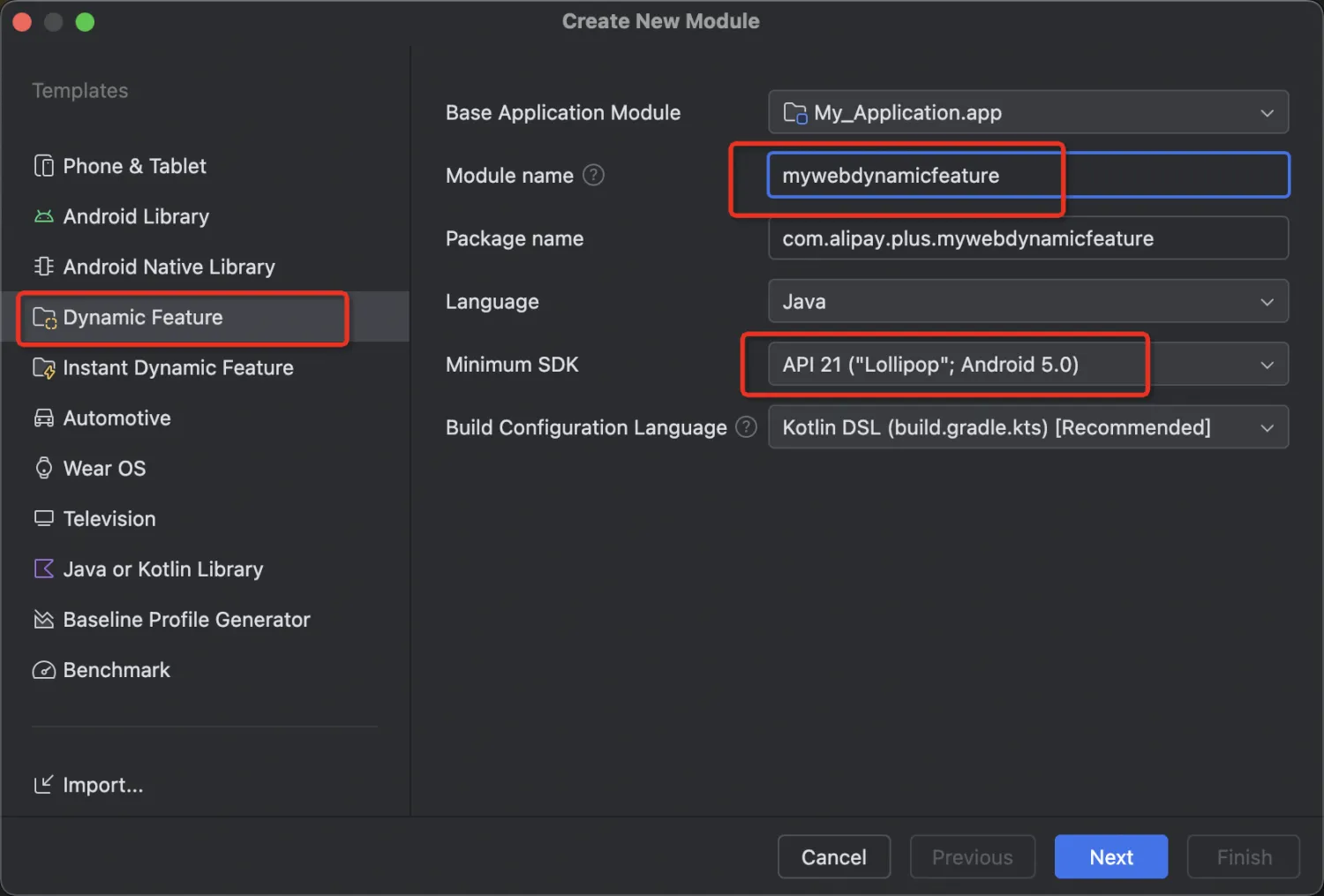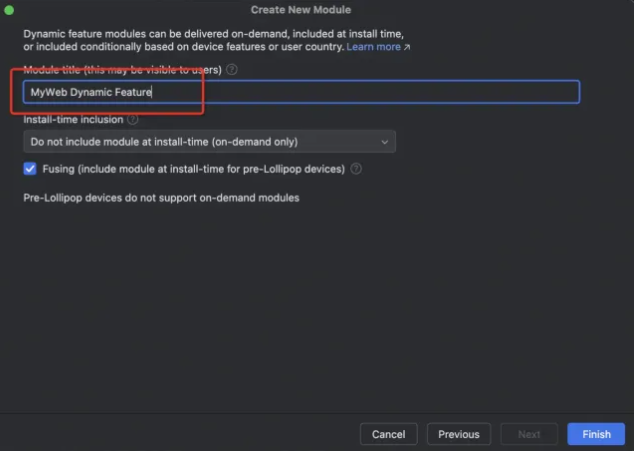Support MYWeb module/dynamic feature in SDK
IAPMiniProgram SDK designs a unified module dynamic delivery solution that allows the super app to download and install the required modules per your requirements to run your application. In order to enhance the performance and rendering capability of mini programs, MYWeb module/dynamic feature is supported
Integration ways
To realize the MYWeb feature, you can choose one of the following integrations ways. But it's highly recommended to use the Dynamic integration way.
- Static integration: The direct dependency is in the project, which is packaged into the APK along with the project.
- Dynamic integration: Based on Google Dynamic Feature capability, download the APK from the Google Play Store when the application is opened. This can reduce the APK size when downloading and improve users' downloading experience.
Static integration
In the build.gradle file of the project app, add the iapminiprogram-myweb depedency as the following code sample:
Note: Obtain the latest iapminiprogram_version version in the Android Release Notes.
dependencies {
implementation "com.alipay.plus.android:iapminiprogram-myweb:{iapminiprogram_version}"
}Dynamic integration
Prerequisite
Make sure that the module name (supporting the MYWeb feature) is mywebdynamicfeature.
Step 1. Create the “mywebdynamicfeature” dynamic module
- In your project, click Create new module > Dynamic Feature to start creating a new module. (see the following figure)
- Choose the Base Application Module properly
- Fill in the module name

- Fill in the Module title (see the following figure). By default, "MyWeb Dynamic Feature" is used.

- Note: In the Install-time inclusion drop-down list, choose (on-deman only).
- Click Finish to finish creating the
mywebdynamicfeaturemodule.
Step 2. Confirm the correctness of the AndroidManifest file
The default configurations in the AndroidManifest file are generated by the system. There is no need to make any changes in this file. You need to check and confirm the correctness of the file.
<?xml version="1.0" encoding="utf-8"?>
<manifest xmlns:android="http://schemas.android.com/apk/res/android"
xmlns:dist="http://schemas.android.com/apk/distribution">
<dist:module
dist:instant="false"
dist:title="@string/title_mywebdynamicfeature">
<dist:delivery>
<dist:on-demand />
</dist:delivery>
<dist:fusing dist:include="true" />
</dist:module>
</manifest>Step 3. Confirm the dynamic repository is imported into the main module
In the build.gradle file of the project app, the system generates the following code by default. This is because that you choose the Base Application Module in the previous Step 1.
android {
dynamicFeatures = [':mywebdynamicfeature']
}In order to make the mywebdynamicfeature dynamic module take effects, must add the following codes in the build.gradle file:
android {
packagingOptions {
jniLibs {
useLegacyPackaging true
}
}
}Step 4. Import the dependency to support the dynamic feature
Import the dependency in the following files:
- In the build.gradle file of the project app, add the following codes to import the
iapminiprogram-dynamic-featuredependency.
Note: Check the latestiapminiprogram_versionversion in the Android Release Notes.
dependencies {
implementation "com.alipay.plus.android:iapminiprogram-dynamic-feature:${iapminiprogram_version}"
}- In the build.gradle file of the dynamic module, add the following codes to import the
iapminiprogram-mywebdependency.
dependencies {
implementation "com.alipay.plus.android:iapminiprogram-myweb:${iapminiprogram_version}"
}Step 5. Configure to use the SplitCompat tool
In order to use the SplitCompat tool, need to finish the following configurations:
- In the build.gradle file of the project app, add the following codes to import dependencies accordingly:
// In your app’s build.gradle file:
...
dependencies {
// This dependency is downloaded from the Google’s Maven repository.
// So, make sure you also include that repository in your project's build.gradle file.
implementation 'com.google.android.play:feature-delivery:2.1.0'
// For Kotlin users, also add the Kotlin extensions library for Play Feature Delivery:
implementation 'com.google.android.play:feature-delivery-ktx:2.1.0'
...
}- Turn on the
SplitCompatin your application based on the following different cases.
Case | To do |
If you have a customized application | You need to add the following codes in the attachBaseContext() function of your current application: copy |
If you do not have a customized application | You need to define a new application as the following codes, which inherits copy |
Step 6. (Optional) Optimize the MyWeb dynamic download experience
If you want to optimize the MYWeb dynamic download experience, for example whether a custom dialog box is displayed to explain the reason for downloading, knowing the download status, and so on, to achieve these experiences, use the GriverDynamicFeatureExtension interface.
Next steps
Configure the authorization code
After you integrate the MyWeb module/dynamic feature:
- You need to provide the package name of your application and SHA256 signature.
We will provide you with the authorization code for MYWeb accordingly. - Then in the Android project, you need to configure the authorization code for
releaseanddebugin theAndroidManifest.xmlfile and thebuild.gradlefile. Refer to the following code sample:
AndroidManifest.xmlfile:
<application>
<!-- configure ${activation_code} placeholder -->
<meta-data
android:name="com.alipay.myweb.init.ACTIVATION_CODES"
android:value="${activation_code}"/>
</application>build.gradlefile:
android {
buildTypes {
release {
/* configure the Release activation_code */
manifestPlaceholders = [
activation_code: "mg*****...="
]
}
debug {
/* configure the Debug activation_code*/
manifestPlaceholders = [
activation_code: "4X*****...=="
]
}
}
}Note:
- If the authorization code is incorrect, MYWeb module/dynamic feature will not be enabled and will automatically fall back to the system web view (
webview). - If you have multiple signatures and package names, need to configure the authorization code based on the different environment accordingly.
FAQ
For troubleshooting, refer to the Android SDK FAQ.